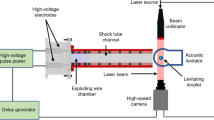Abstract
The extent to which the carrier fluid wets the walls of a microchannel is crucial in the droplet formation process for segmented flow microfluidic applications and can be influenced by the use of surfactants. Surfactants dynamically modify the microchannel surface leading to stabilization of the two phase interface, affecting the droplet formation process. An experimental study of the influence of hydrophobic surfactant (Span 80) during the formation of water-inoil droplets in a T-shaped microchannel geometry is presented and the wetting properties of the microchannel walls were characterized. The range of data to be analyzed on the microscale is estimated from the macroscopic interfacial tension and contact angle measurements. The critical micelle concentration (CMC) level at the microscale was estimated by observing the trend of droplet length variation with concentration of surfactant in a microchannel. Microchannels used in this work were fabricated using softlithography methods and bonded using a custom-made plasma bonding setup that does not require an ultra high vacuum chamber and hence saves the fabrication cost.
Similar content being viewed by others
References
Chin, C.D., Linder, V. & Sia, S.K. Lab-on-a-chip devices for global health: Past studies and future opportunities. Lab Chip 7, 41–57 (2007).
Wu, M.H., Huang, S.B. & Lee, G.B. Microfluidic cell culture systems for drug research. Lab Chip 10, 939–956 (2010).
Khademhosseini, A., Langer, R., Borenstein, J. & Vacanti, J.P. Microscale technologies for tissue engineering and biology. Proc. Natl. Acad. Sci. USA 103, 2480–2487 (2006).
Qasaimeh, M.A., Ricoult, S.G. & Juncker, D. Microfluidic probes for use in life sciences and medicine. Lab Chip 13, 40–50 (2013).
Gernaey, K. et al. Monitoring and control of microbioreactors: An expert opinion on development needs. Biotechnol. J. 7, 1308–1314 (2012).
Sung, J.H. et al. Microfabricated mammalian organ systems and their integration into models of whole animals and humans. Lab Chip 13, 1201–1212 (2013).
Mandenius, C.-F. et al. Toward preclinical predictive drug testing for metabolism and hepatotoxicity by using in vitro models derived from human embryonic stem cells and human cell lines: a report on the Vitrocellomics EU-project. Altern. Lab Anim. (ATLA) 39, 147–171 (2011).
Khetani, S.R. & Bhatia, S.N. Microscale culture of human liver cells for drug development. Nat. Biotechnol. 26, 120–126 (2008).
Lee, P.J., Hung, P.J. & Lee, L.P. An artificial liver sinusoid with a microfluidic endothelial-like barrier for primary hepatocyte culture. Biotechnol. Bioeng. 97, 1340–1346 (2007).
Fritzsche, M., Fredriksson, J.M., Carlsson, M. & Mandenius, C.-F. A cell-based sensor system for toxicity testing using multiwavelength fluorescence spectroscopy. Anal. Biochem. 387, 271–275 (2009).
Greif, D., Galla, L., Ros, A. & Anselmetti, D. Single cell analysis in full body quartz glass chips with native UV laser-induced fluorescence detection. J. Chromatogr. A 1206, 83–88 (2008).
Schulze, P., Ludwig, M., Kohler, F. & Belder, D. Deep UV laser-induced fluorescence detection of unlabeled drugs and proteins in microchip electrophoresis. Anal. Chem. 77, 1325–1329 (2005).
Kim, L., Toh, Y.-C., Voldman, J. & Yu, H. A practical guide to microfluidic perfusion culture of adherent mammalian cells. Lab Chip 7, 681–694 (2007).
Baudoin, R., Griscom, L., Prot, J.M., Legallais, C. & Leclerc, E. Behavior of HepG2/C3A cell cultures in a microfluidic bioreactor. Biochem. Eng. J. 53, 172–181 (2011).
Leclerc, E., Sakai, Y. & Fujii, T. Cell culture in 3-dimensional microfluidic structure of PDMS (polydimethylsiloxane). Biomed. Microdevices 5, 109–114 (2003).
Toh, Y.-C. et al. A novel 3D mammalian cell perfusion-culture system in microfluidic channels. Lab Chip 7, 302–309 (2007).
Leclerc, E., Sakai, Y. & Fujii, T. Perfusion culture of fetal human hepatocytes in microfluidic environments. Biochem. Eng. J. 20, 143–148 (2004).
Sung, J.H. & Shuler, M.L. In vitro microscale systems for systematic drug toxicity study. Bioproc. Biosyst. Eng. 33, 5–19 (2010).
Ma, B., Zhang, G., Qin, J. & Lin, B. Characterization of drug metabolites and cytotoxicity assay simultaneously using an integrated microfluidic device. Lab Chip 9, 232–238 (2009)
Trujillo, T.C. & Nolan, P.E. Antiarrhythmic agents: drug interactions of clinical significance. Drug Safety 23, 509–532 (2000).
De Bartolo, L. et al. Long-term maintenance of human hepatocytes in oxygen-permeable membrane bioreactor. Biomaterials 27, 4794–4803 (2006).
Author information
Authors and Affiliations
Corresponding author
Rights and permissions
About this article
Cite this article
Bashir, S., Solvas, X.C.i., Bashir, M. et al. Dynamic wetting in microfluidic droplet formation. BioChip J 8, 122–128 (2014). https://doi.org/10.1007/s13206-014-8207-y
Received:
Accepted:
Published:
Issue Date:
DOI: https://doi.org/10.1007/s13206-014-8207-y




